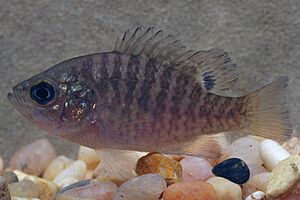Bantam sunfish facts for kids
Quick facts for kids Bantam sunfish |
|
|---|---|
 |
|
| Conservation status | |
| Scientific classification |
The bantam sunfish (Lepomis symmetricus) is a small, interesting freshwater fish. It belongs to the Lepomis family, which includes other sunfish. You can find this fish mostly in Louisiana, parts of southeastern Texas, southern Arkansas, and some areas of western Kentucky and western Tennessee.
Contents
What Does the Bantam Sunfish Look Like?
The bantam sunfish has a dark body. It usually has about ten stripes that go up and down its sides. A cool thing about this fish is that its lower jaw sticks out a bit more than its upper jaw.
Where Do Bantam Sunfish Live?
Bantam sunfish live in a specific area of the United States. Their main home is in states like Louisiana, southeastern Texas, southern Arkansas, and parts of western Kentucky and Tennessee. They are also found, but less often, in southwestern Illinois, the Missouri Bootheel, McCurtain County in Oklahoma, and some areas of Mississippi.
These fish like to live in calm, slow-moving waters. You can often find them in places like sloughs, oxbow lakes, ponds, and swamps. They prefer areas with lots of plants like spatterdock, American lotus, and duckweed. The bottom of their habitat is usually made of mud, silt, or dead plant material.
What Do Bantam Sunfish Eat?
Bantam sunfish have a varied diet. They eat different kinds of small creatures found in the water. Studies have shown they often eat tiny snails (called gastropods), young dragonfly larvae, and very small crustaceans.
Smaller bantam sunfish, less than 21 millimeters long, mostly eat aquatic bugs, tiny crustaceans, and midge larvae. Bigger bantam sunfish, over 40 millimeters long, enjoy eating snails, amphipods, and larger fly larvae. Interestingly, bantam sunfish of all sizes seem to like eating dragonfly larvae.
Even though many fish that eat other fish live in the same areas, scientists haven't seen bantam sunfish being eaten by them. This means they might not have many known predators.
Life Cycle of the Bantam Sunfish
Bantam sunfish usually lay their eggs from mid-April to early June. Only the larger males, who are at least one year old and about 40 millimeters long, are ready to spawn. Females can also start laying eggs at one year old, even if they are a bit smaller (around 34 millimeters). However, the biggest females are usually the ones who lay the most eggs.
Scientists don't have a lot of information about where and how bantam sunfish build their nests in the wild. One observation noted that they spawned in small dips in the mud and leaf litter at the bottom of a pool.
Protecting the Bantam Sunfish
The biggest danger to the bantam sunfish is when their homes are damaged by human activities. Things like draining wetlands, digging channels, and turning swamps into farmland are a major threat. As more people move to the southern United States, more land and water resources are used, which can harm the fish.
Because bantam sunfish don't live very long, collecting too many of them for research or education could also become a problem. Currently, there aren't many specific programs to help bantam sunfish populations. However, Illinois is thinking about putting them back into some of their old habitats. It's hard to know if enough bantam sunfish are reproducing because we don't know much about their nesting habits in the wild.


